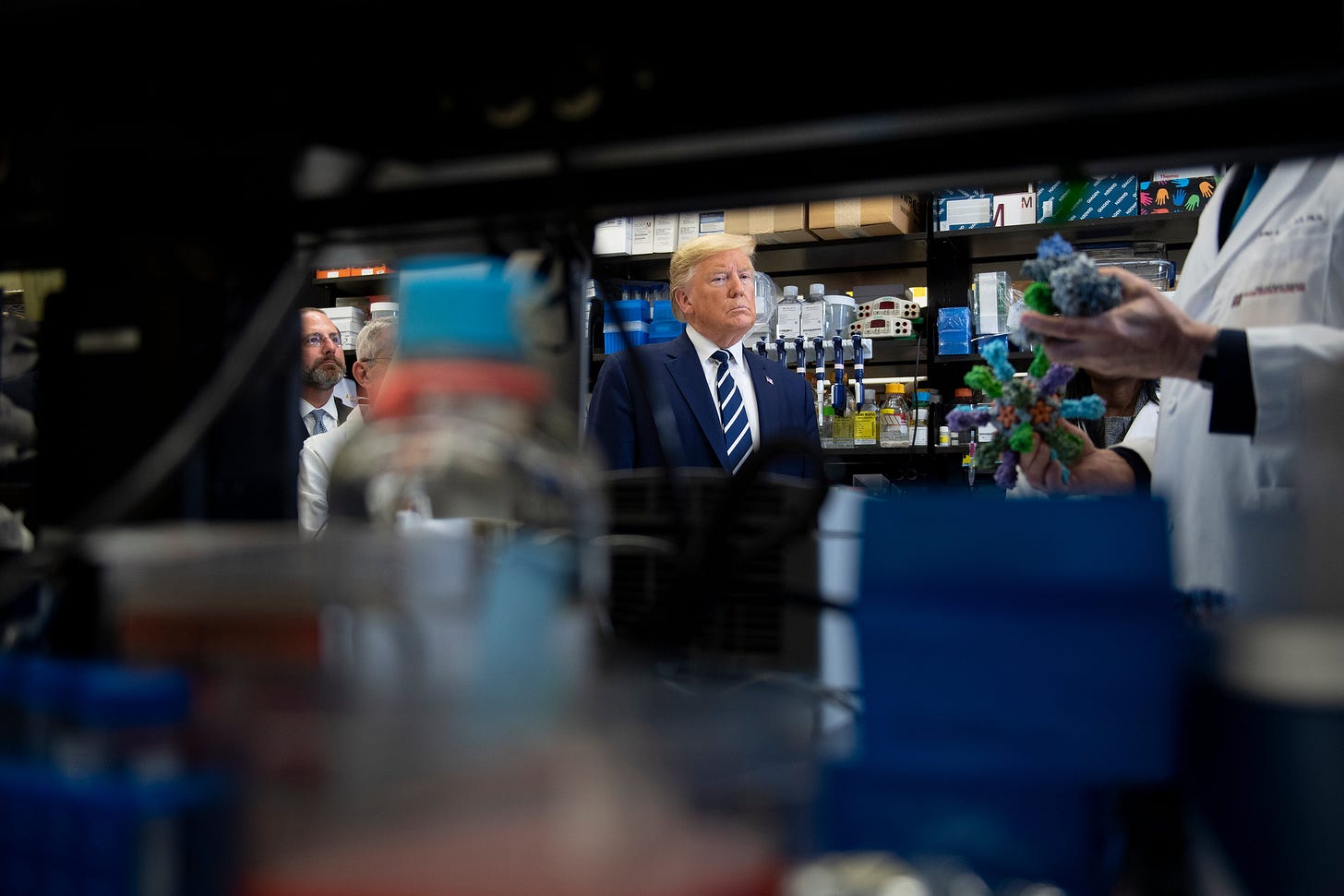Under Trump, Laws Are Just Vibes
The administration’s dangerous attack on scientific funding is part of a pattern of illegality and abuse.

IT MIGHT SEEM LIKE A LITTLE THING, just one snowflake in the blizzard of Trump’s first three weeks back in office: On Friday, the administration announced that it would cap the overhead, or “indirect” rates, that the National Institutes of Health allows on its grants to universities. These will now max out at 15 percent. If you don’t work in a university or aren’t involved in medical research, this might not seem like a big deal. But for the researchers and administrators who understand how university and medical center budgets work, it triggered mass panic. They’re now facing a $4 billion funding cut. For our largest research institutions, medical schools, and medical centers, it could leave up to a $100 million or greater hole in their annual budgets.
We can debate about how NIH funds the infrastructure costs for doing research—including the buildings, scientific labs and materials, training of scientists, maintenance, support staff, clinical care, and ever-rising costs of ensuring compliance with federal rules about how funds are spent. We can also debate how the overhead rate is determined. Those are all fair subjects for discussion. But let’s be clear about what this NIH cap on overhead means in terms of practical politics: It is the Trump administration taking a swing at two favorite targets: science and higher education.
If you want to take a whack at the American scientific enterprise and higher education in general, it’s a smart way to do it. The issue is wonky and difficult for the public to understand—who knows anything about indirect rates? And university administrators don’t make the most attractive faces for public appeals for support.
But the effects will be felt well beyond universities, medical schools, and medical centers.1
First, the cuts will especially damage medical research, care, and training. Medical schools and centers are among the largest recipients of these funds. Americans rely on these schools for their health care, with teaching hospitals providing the highest quality of care. Medical centers and schools are also where the vast majority of clinical trials for new medical treatments happen. Notably, private health care entities, including the pharmaceutical industry, are deeply reliant on the biomedical and health research produced at universities across the country. Isabella Eckerle, the Director of the Geneva Centre for Emerging Viral Diseases, said on Bluesky: “I feel so, so sorry for my colleagues in the US. How can someone destroy the decades-long lighthouse of science in less than 2 weeks? The US used to be the place to go to do great science and/or learn state-of-the-art medicine. It’s just pure madness.”
Second, it will cripple a world-beating American industry. American higher education generates lots of stable middle class jobs, and not just in blue states. It generates large positive economic externalities. This handy tool lets you estimate the economic impact of these funds in your state. Universities in places like Michigan, Texas, Wisconsin, Texas, and Georgia can, in no small part because of the quality of their research programs, attract international students who generate about $40 billion per year, subsidizing American students. “Red states have universities too,” observed one unnamed Trump official after the announcement. Although these cuts are presented as budget “savings,” their real effect will be to deeply damage a successful industry, many state economies, and ultimately medical care and our health.
So, yes, the effects of this change will be harmful, maybe dire. But there’s another reason the Trump administration shouldn’t be capping the NIH overhead rate, a simpler reason: It’s illegal.
A LAW ENACTED IN 2024, the Further Consolidated Appropriations Act prohibits the administration from changing overhead rates without congressional approval. Congress, in its infinite wisdom, has reserved this to be a congressional power. The practice began in 2017, the last time that Trump tried to cut indirect rates, so there is no real doubt about congressional intent. When Project 2025—which President Trump insisted was unaffiliated with his policy agenda—proposed cutting indirect rates, the author of that section identified Congress as the relevant actor, not Trump.
That should be the end of the story.
But of course it won’t be. The Trump administration announcement made no reference to the law. This is becoming a distinct pattern: The White House issues an executive order, memo, or press release. The order makes a legal claim that grants the power to make sweeping changes. Everyone panics. Then someone points out it sounds pretty illegal, citing statute and precedent. But we still panic anyway, because we no longer believe the president considers himself bound by the law.
Examples abound:
The president has asserted that he can shutter federal agencies created by statute. He cannot. Only Congress can do so. Nevertheless, the Trump administration is moving to end USAID, the Consumer Financial and Protection Bureau, and reportedly the Department of Education. Offices are shut, work has stopped, websites are going dark.
The president claims he can engage in a mass firing of civil servants. He has no such legal authority. But he is putting entire agency staff on administrative leave indefinitely, using an authority that Congress wanted to use sparingly for individual employees under investigation. Rather than use actual legal authorities to offer federal employees buyouts, Trump created a “deferred resignation” program that has no basis in law. He is also stopping agency payments, violating the Impoundment Control Act.
The president has fired inspectors general and heads of independent agencies in clear violation of existing law. He has told members of the Senior Executive Service, the government’s most senior public managers, that they are now “at will”—effectively turning them into political appointees, and plans to reclassify tens or even hundreds of thousands of civil servants into Schedule F appointees.
I am picking examples from my particular interest, which is public administration. But the pattern holds across policy areas: Assert a broad claim of power, and then act as if you have this power. It may be that in some cases, the courts will agree with Trump. But in others they will not, and Trump can do a lot of damage while they are making up their mind.
We are seeing an administration that treats the law as the opening offer in a hardball negotiation, while ignoring the actual body that makes laws: Congress. After railing against the administrative state, the Trump administration is engaged in a massive spree of legally dubious executive actions.
SMASHING LEGAL AGREEMENTS AND CONSENSUSES that have evolved over decades is bad policymaking, especially when undertaken by ideological cranks or political novices who are indifferent to the outcomes. The examples I have identified will hurt American science and state capacity. But I think the damage is deeper, since it also affects how we think of ourselves as a country bound by the rule of law.
First, we are witnessing a model of constitutional change without changing the constitution. As Justice Scalia noted, changing the text of the Constitution in modern America is nearly impossible. Instead, it is changed through judicial interpretation. The Trump administration is betting that the Supreme Court will agree to an understanding of the Constitution where the president has king-like powers that are nowhere specified in the Constitution—the so-called unitary executive theory. The Trump v. U.S. ruling on presidential immunity authored by John Roberts last year shows a willingness to move in that direction, at the demand of a president who will clearly abuse such powers. With the major questions doctrine, the courts have granted themselves license to stop presidents who twist congressional interpretations to grant themselves too much power. They did it with Biden’s effort to forgive student debt. Will they do so with Trump’s extraordinary overhaul of the executive branch in defiance of statute?
Second, the Trump administration is creating a sense that the law is just vibes now. If you question the legality of Trump’s actions on social media, you’re likely to hear from a lot of people who say variations on “Oh, you rube, you still think the law matters.” This belief is deeply damaging, if for no other reason that it is strategically foolish to concede that the rule of law is a fiction. Contest everything! Expose the hypocrisy! Historically, judges have been at least somewhat attentive to public beliefs when interpreting the law. And the Trump administration is following court injunctions so far. Notwithstanding JD Vance’s ruminations about judges, the Trump administration is listening to the courts—so far—even if it is ignoring Congress.
Third, the bothsidesing of the law has to stop. Headlines typically present Trump’s actions as a matter of legal dispute. The administration and perhaps some conservative lawyers say one thing, while almost all experts, decades of precedent, and the plain meaning of the text say another.
This bothsidesing also reflects the political economy of American legal scholarship, where you can always find someone to offer the most counterintuitive legal take. So, you learned in school that the Founders were wary of centralized power? Actually, they yearned for a unitary executive with king-like powers. The plain meaning of the Fourteenth Amendment conveys birthright citizenship? Not so fast, my friend: Some lawyers are working on an op-ed to say the authors of the amendment meant the opposite of what they wrote.
I like how the Onion captured the current moment: “Trump Claims He Can Overrule Constitution With Executive Order Because Of Little-Known ‘No One Will Stop Me’ Loophole.” The satire is worryingly close to Trump’s actual statements: “I have an Article 2 where I have the right to do whatever I want as president.”
For decades, conservatives rolled out originalist approaches to constitutional interpretation as well as doctrines, like the unitary executive theory for rethinking the relationship among the branches of government. Legal scholars and the press have generally treated these as good-faith engagement with the law, rather than as tools allowing well-funded political forces to get what they want. In Trump’s first term, it became clear that the conservative legal movement cared more about conservative policy goals than about the rule of law. In his second term, we are likely to see that they now care more about the exercise of power by Donald Trump than about the Constitution.
Donald Moynihan is the Harris Family Professor at the Ford School of Public Policy at the University of Michigan. He blogs at Can We Still Govern?
Full disclosure: I am a faculty member at a university that receives lots of NIH funding (Go Blue!).





